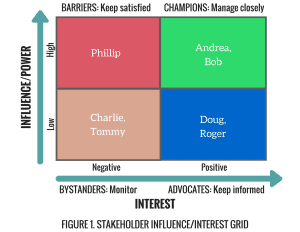Eight Powerful Project Management Processes Part 2: Stakeholder Analysis
/*Eight Powerful Project Management Processes Part 2: Stakeholder Analysis

Stakeholder Analysis is Part Two of our series on the “Eight Powerful Project Management Processes,” a look at crucial project management processes that are included in our toolkit, Essential Gear for Project Managers.
Stakeholder analysis was once included under project communications management, but it encompasses much more than just communication. Proper stakeholder analysis and management can help project managers find powerful allies to assist the project and keep negative influences from disrupting it.
The best practices and pitfalls for stakeholder analysis include:
1. Define the stakeholders.
A stakeholder is anyone who is affected by, or can influence, the project outcome. Primary stakeholders, such as executive sponsors, management or company employees, have a direct stake in the project and are usually involved in all aspects. Secondary stakeholders, such as vendors, government entities, and members of the public, are those indirectly affecting or affected by business operations.
2. Include all stakeholders.
A common pitfall is missing stakeholders who turn out to be crucial to project success. Leaving someone out can do more than just amplify negative feelings; project managers are also missing out on potential allies who can help. If you’re not sure about a stakeholder, find someone to ask.
3. Create and update stakeholder matrices.
The stakeholder influence matrix is a graphic with four quadrants to map stakeholders’ level of power/influence and interest in the project. Positive-interest stakeholders include project champions, who have a high degree of influence, and advocates, who have low influence but should be kept informed. Negative-interest stakeholders consist of barriers, who have high power, and bystanders, who have less power but should still be accounted for.
The stakeholder engagement matrix maps these levels and indicates where stakeholders are and where you would like them to be. This matrix is useful for helping establish a plan to guide stakeholders to the desired level of engagement.
4. Improve stakeholder engagement.
Knowing the stakeholders and their status is a good start, but where do you want them to be and how do you get them there? If you have identified a possible advocate, invite that stakeholder to meetings or to receive regular project updates. Likewise, if a stakeholder is raising concerns about the project, take time to listen to those concerns and offer solutions. Both of these are small steps that could pay off well for the project.
5. Safeguard stakeholder information.
Stakeholder details are sensitive and should be kept privately. Just as with social media, do not commit something to writing that you don’t want to share with the world. If a sensitive detail is revealed, a good relationship can fall apart or a bad one can become worse.
Stakeholder analysis is important because a project needs the support of a wide variety of people in order to succeed. Keeping barriers at bay and champions close by is one way to help guide your project to success. For more information on keeping your stakeholders happy, download our free ebook, Top 5 Stakeholder Concerns: A Guide to Mutual Success.
How often do you use stakeholder analysis on your projects? Let us know in the comments.
Essential Gear for Project Managers is a toolkit with the eight essential project management processes you need to deliver projects on time, on budget, and exceeding expectations. Delivered to you via intuitive templates and a handbook describing best practices and pitfalls.